WMG News
WMG welcomes Siam Cement Group
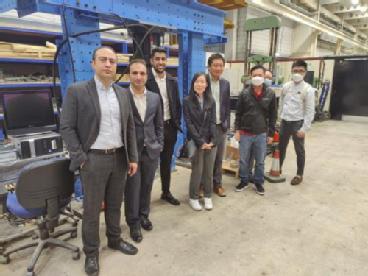 WMG and the School of Engineering at the University of Warwick were pleased to welcome Siam Cement Group (SCG) to campus recently.
WMG and the School of Engineering at the University of Warwick were pleased to welcome Siam Cement Group (SCG) to campus recently.
A senior delegation of directors at SCG, enjoyed an extensive tour of the University’s state-of-the-art facilities including WMG’s Advanced Materials and Manufacturing Centre (AMMC).
SCG, based in Thailand is one of the world’s largest cement and concrete manufacturers. The Group is investing in world-leading technology for construction including Concrete4Change. Concrete4Change is an award-winning R&D start-up, supported by WMG and the School of Engineering, developing net-zero concrete technology.
Dr Sid Pourfalah, Founder and CEO of Concrete4Change, and Honorary Associate Professor at the University of Warwick commented: “We are delighted to host SCG at the University of Warwick. The University has been an invaluable R&D partner in our journey so far, and with SCG now entering into collaboration with Concrete4Change, we can scale our presence in the market and create the true net-zero pathway that the concrete industry desperately needs.”
Read more about the Concrete4Change project here: CO2 consuming concrete technology showcased at COP26 to be tested at University of Warwick - WMG :: News
University of Warwick proposes new quality and safety regulations report for micromobility vehicles
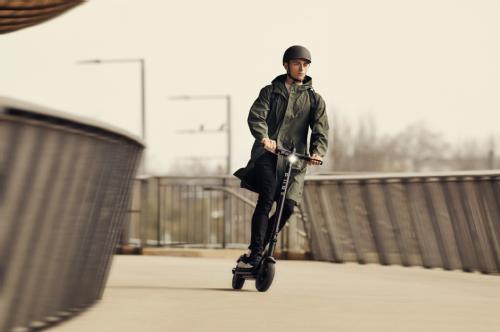
• Legal framework proposed by researchers at the University of Warwick lays out how future micromobility vehicles such as eScooters could be designed and operated in the UK by mid-2023.
• New standards would require manufacturers to develop safer and better quality vehicles.
• The roadmap proposes new powers of enforcement to deter antisocial and illegal use.
• Conclusions were drawn from a wide-ranging consultation with over 100 organisations.
The UK is the last major Western economy not to legislate ‘Powered Micro Vehicles’. The University of Warwick wants to change that and has proposed a new set of regulations for allowing micromobility vehicles, such as e-scooters to operate legally in the UK. The report looks at ways to improve the quality and safety of models available, as well as providing clear guidance for authorities to deal with unsafe behaviour.
WMG researchers at the University of Warwick, with support from Cenex, has published ‘Micromobility, a UK roadmap’. It is a regulatory framework that provides a set of standards for eScooters, a cargo variant and other micro vehicles, to be operated legally in the UK, which is aimed at supporting regulatory change through parliament.
100 organisations representing road users, safety groups, transport authorities and industry have helped shape the roadmap. If the roadmap was adopted, the public could legally operate eScooters and other micromobility vehicles by mid-2023.
Micromobility is a key part of achieving net-zero emissions for transport. For many journeys, particularly short journeys, walking or using micromobility are much better for the environment than using a car. The economic benefits are also compelling both in the cost of the vehicle and the manufacturing opportunities. Without change many manufacturers may leave the country.
The key recommendations of the roadmap are:
• The creation of a new vehicle category “Powered Micro Vehicles” and three initial new vehicle types in the category: eScooter, Light Electric Cargo Vehicle, Electric Light Moped.
• Specific standards and regulations for each vehicle type, including speed limits and weight limits.
• Vehicles must be registered and be visually identifiable.
• Cardinal design requirements around minimum wheel size and redundancy of braking systems, so there is a secondary method of slowing the vehicle down.
• Daytime running lights, a sound emitter and indicators are required to improve visibility for current road users.
• No use on the pavement in any circumstance, and instead use on roads and cycle-ways.
• Minimum ages for operating the vehicles, and PPE recommendations.
• New powers for local policing and PCSOs in England and Wales, to fine breaches and illegal use.
Lead author John Fox, Programme Director at WMG at the University of Warwick, said “The purpose of the 'Micromobilty, a UK roadmap’, is to provide regulations on how powered micromobility vehicles could be designed and operated in the UK.
“It’s important that these vehicles are high quality, safe, and legal. They can provide a low-carbon mobility option which is available to everybody, allowing us to make choices about how we travel, and stimulating future innovation which will accelerate a market for UK manufacturers.”
Robert Evans, CEO at Cenex comments, “In order to lower emissions from transport, it is crucial we find a way forward that allows the UK micromobility market to grow sustainably and safely for all.
“The growth in e-bike use and the popularity of e-scooter trials have demonstrated that electric powered micro vehicles will have a significant role in our future transport systems. The right legislation and regulations must enable this whilst minimising any potential negative impacts.
“Cenex is proud to have supported WMG in this work and looks forward to seeing the benefits and impacts.”
Richard Dilks, Chief Executive at CoMoUK, said “Further to our recent letter to the Transport Secretary, CoMoUK sees a clear need for legislation to fill the void we currently have over micromobility options such as escooters beyond the welcome rental scheme trials. We welcome the announcement from the Transport Secretary that the Government intends to legislate. We need all the options we can lay our hands on to reduce our over-reliance on private cars in particular and motorised mileage in general, and proposals such as these help put flesh on the bones of how we can fill the gap.”
Adam Norris, Founder of Pure Electric, said, “As Europe’s largest e-scooter retailer we are working hard to support the Government with bringing in legislation. The UK still remains the only large economy not to have legalised and regulated private e-scooters. It is frustrating that the UK has fallen behind the rest of Europe, however, the detailed work from the experts at the University of Warwick demonstrates that the UK has the potential to become a world leader in micro-mobility.”
Over the course of six months, the researchers held five workshops with over 100 organisations represented. Participants came from a broad range of stakeholders, including user groups – such as road safety groups, charities and cycling groups - service providers, vehicle developers and manufacturers, local and regional transport authorities, and policymakers. These workshops examined a range of options covering vehicle types, vehicle safety, maximum speeds, to try and form a consensus.
• The roadmap is available online: short version and long version
• The image (taken on private land) is courtesy of Pure Electric.
WMG is hosting its 2nd micromobility event on 9th June where the roadmap will be debated by key industry stakeholders. The event will also feature the latest data from industry and technology experts, with the opportunity to trial some of the latest micromobility solutions
Reusable and customised facemask to keep healthcare workers safe thanks to digital supply-chain
 Throughout the pandemic the filtering facepiece 3 respirator (FFP3) mask was heavily in demand, as it is the most widely used respiratory protective equipment in UK healthcare system. However, according to a study with health workers from 32 hospitals, the overall fit-testing pass rates had a mean pass rate of 81%.
Throughout the pandemic the filtering facepiece 3 respirator (FFP3) mask was heavily in demand, as it is the most widely used respiratory protective equipment in UK healthcare system. However, according to a study with health workers from 32 hospitals, the overall fit-testing pass rates had a mean pass rate of 81%.
MyMaskFit with their NHS Nurse co-Founder saw this statistic in reality in setting up the COVID-19 Wards, and with inspiration from the Ventilator Challenge UK they have created a reusable, customised facemask to protect medical workers during and after the pandemic.
The mask is unique as it has:
§ Fully customised fit according to individual’s face. This will ensure a high fit-testing pass rate and better protection.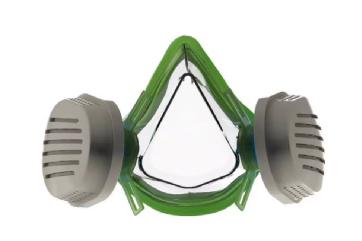
§ Different from the traditional one fits all masks, customised mask will also provide the most comfortable wearing experience that enable clinical workers wearing them for long time.
§ Local 3D printing supply chain to ensure a fast and flexible reaction to the demand with short lead time.
However, to ensure MyMaskFit could be rolled out and mass produced it was important to secure a sustainable supply chain. This is where the WMG Supply Chain Research Group stepped in and helped MyMaskFit to create a digital solution, taking advantage of emerging distributed manufacturing.
Distributed manufacturing consists of using global and remote expertise, producing parts locally and diversifying supplier network productions, researchers from WMG decided to use distributed manufacturing to create a digital supply-chain marketplace, which is attractive to buyers and suppliers, as it uses the insight gained from other marketplace examples to address known barriers and issues. This means that companies can transform customer feedback into designs and products that can be achieved within days through such a dynamic and distributed supply chain.
The WMG Accelerator Team also helped, by leveraging their existing knowledge learned from UK Collaborative Commerce Marketplace (UKCCM). UKCCM is a digital marketplace created by WMG Accelerator Team, which aims to increase sales and lower costs through providing easy access to the core competences and capabilities of small and medium-sized enterprises.
MyMaskFits was then able to meet the classification of cloud-additive manufacturing with a touch of the platform's support (marketplace) to amplify the on-demand supply chain to a larger scale.
Carl Che from the WMG SCRG at the University of Warwick comments: “We are glad that our distributed manufacturing archetype and marketplace archetype helped MyMaskFit to form their business model from academic side. It feels great knowing a better mask can potentially help more NHS workers or even save more lives.
“From a macro perspective, two separated models (distributed manufacturing and B2B marketplace) perfectly help each other out. This project can potentially sketch out an emerging pattern of the future manufacturing in the UK.”
Paul Perera from MyMaskFits comments: “Our mask is unique as it is reusable and customisable, however in order for it to be mass produced and manufactured easily we needed a sustainable supply-chain in place.
“WMG at the University of Warwick have helped us meet our customer’s needs and expectations by helping us secure a sustainable and digital supply-chain, this means we can easily check our suppliers availability and prices and provide MyMaskFit quickly and at a competitive price.”
ENDS
NOTES TO EDITORS
High-res images available at:
https://warwick.ac.uk/services/communications/medialibrary/images/november_2021/mask_on_face.jpg
Caption: The MyMaskFit reusable and customised facemask
Credit: MyMaskFit Photographer: Ed Felton
https://warwick.ac.uk/services/communications/medialibrary/images/november_2021/mask_1.jpg
Caption: The MyMaskFit reusable and customised facemask
Credit: MyMaskFit Photographer: Ed Felton
https://warwick.ac.uk/services/communications/medialibrary/images/november_2021/mask_4.png
Caption: The MyMaskFit reusable and customised facemask
Credit: MyMaskFit Photographer: Ed Felton
5 April 2022
The University of Warwick supports RIFT Technology with a greener cost-effective electric motor
A cheaper and more environmentally friendly electric motor for electric vehicles is a step closer to market with the support of WMG at the University of Warwick.
WMG has provided valuable knowledge and expertise in developing a UK focused, cost-effective production and supply chain for RIFT (Reduced  Induction Field Torque) Technology’s development of RIFT-10; a design for electric motor drives that reduces copper and magnet weight reduction by around 50% and lower cost by 75%.
Induction Field Torque) Technology’s development of RIFT-10; a design for electric motor drives that reduces copper and magnet weight reduction by around 50% and lower cost by 75%.
The aim of the project was to help RIFT Technology; an R&D company bringing a product to market for the first time, advance RIFT-10 to a higher manufacturing readiness level (MRL 7), to get the motor closer to production, by rooting the supply chain in the UK, rather than abroad (given the disruption to supply caused by the pandemic) and supporting production of trial units.
WMG, is committed to delivering UK economic impact and achieving net-zero by supporting industry in accelerating new concepts to commercial reality. This supports the University of Warwick’s approach to sustainability - the Way to Sustainable – which focuses on the real-life implications of creating a sustainable future and the practical challenges of getting there - prioritising research expertise, sustainability in the curriculum, and developing solutions for the benefit of industry and society.
The team of experts at the University has facilitated the RIFT-10 project to deliver on creating revenue, jobs, CO2 reduction, and supply chain growth in the UK.
RIFT Technology has developed the RIFT 10-30 kW motor (RIFT-10) by taking an exciting innovation from their sister business (RIFT Actuators) and working with APC and the Niche Vehicle Network to get the motor to working prototype stage (installed on a G-Whiz). The novel electric motor configuration is proven to generate 10-30kW of power, torque from 0-400Nm and up to 10,000RPM as demonstrated with a prototype vehicle.
The RIFT 10 motor demonstrated unique advantages over conventional EV motors:
Environmental benefits of the project:
· The low sales cost and attractive features of RIFT-10 enable greater/earlier market adoption of EUV’s, resulting in a reduction of CO2 production over ICE vehicles.
· A RIFT-10 weight saving and efficiency over competing EV motor designs increase vehicle range, resulting in less energy usage over alternatives.
· With RIFT-10, equivalent power output is achieved using fewer raw materials (i.e., 85% reduced copper weight and ~85% reduced magnet volume), resulting in less earth material usage as well as fewer material costs.
· Less materials usage results in an estimated 75% reduction in CO2 produced during manufacture. Planned production efficiencies also lead to further CO2 reductions. An estimated 612,000 Tonnes of CO2 would be saved by year 5.
· Development of an EV motors supply chain in the UK for a UK and EU market reduces international shipping of components thus reduces related CO2 production.
Social benefits of the project:
· RIFT-10 creates/safe-guards 50+ much needed and good-quality manufacturing, sales, administration and R&D jobs in the Malvern area with an estimated X14 more UK jobs across the supply chain (over 5-years).
· Growth of RIFT-10 addresses the government’s priority area of ‘Smart Cities’ by allowing smart monitoring of vehicle fleets efficiency performance, usage and other data points. The use of the Internet of Things and resulting analysis can only be as strong as the data input. Traditional alternatives offer no smart functionality.
James Black, WMG Innovation Manager at the University of Warwick said, “The Covid-19 pandemic has been particularly difficult for SMEs and R&D-focused organisations that have previously relied on face-to-face networking events to find new partners, investors, and customers.
“WMG’s network means we’re in a great position to connect UK companies together to help them accelerate their product to the market, and we’re delighted that RIFT Technology has benefited from our extensive background for practical supply chain solutions that have delivered economic and societal value to the project.”
James O’Donnell, Technical Manager from RIFT Technology said, “As a research and development company bringing a product to market for the first time, RIFT Technology needed to bridge the gap between prototype and small-scale production. We had to answer difficult questions such as what to make and what to buy, high level questions such as how to develop a supply chain strategy and practical questions such as how best to select suppliers.
“With a unique blend of academic expertise and industrial experience from the University of Warwick, WMG’s Supply Chain and Operations Group were able to support us in our journey.”
The project took place during the pandemic, meaning several online workshops were carried out targeting topics such as strategic management, supplier selection and decision-making, and end-of-life strategies.
For further stories, click here.
ENDS
4 April 2022
WMG launches EV battery recycling facility
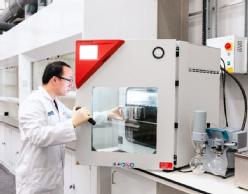 WMG, at the University of Warwick, has revealed its new EV battery recycling scale-up facility, the first of its kind in the UK.
WMG, at the University of Warwick, has revealed its new EV battery recycling scale-up facility, the first of its kind in the UK.
The adoption of electric vehicles has created a huge demand for battery metals such as lithium, nickel and cobalt; and this will accelerate each year as electric vehicles replace conventional vehicles. UK-based OEMs pay hundreds to recycle end-of-life lithium-ion batteries that are then exported abroad for material recovery, with the material later repurchased. Recycling of batteries in the UK will provide a stable and sustainable supply of indigenously sourced metals that will be vital for the UK’s automotive needs.
Anwar Sattar, Lead Engineer at WMG, explains: ‘‘The UK has some of the best research organisations in the world, and this facility will now enable us,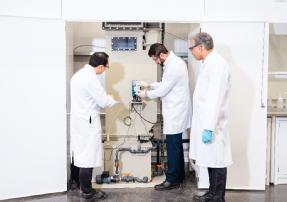 like our international peers, to take our innovations to the EV market direct.
like our international peers, to take our innovations to the EV market direct.
“We can now carry out kilogramme scale research which will allow us to attain data that is much more valuable to the UK industry, allowing them to make informed decisions about issues such as material handling and separation, scalability, product quality and waste production.’’
Professor David Greenwood, CEO of the WMG Centre HVM Catapult and Director of Industrial Engagement adds: “Batteries are a key enabler to the use of zero carbon energy, and they are a great industrial opportunity for the UK. Making them uses significant quantities of valuable materials, so it is essential that they are safely collected and recycled at the end of their useful life – providing the material feedstock for future generations of batteries. Today’s processes recover as little as 50% of the mass of the battery, and require large quantities of energy and chemicals as inputs. This new facility at WMG will allow us to research new recovery techniques which are more effective, cleaner and cheaper to operate.”
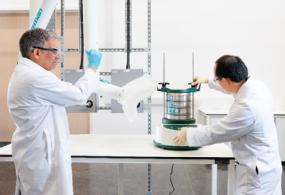 The new recycling facility, funded by the High Value Manufacturing Catapult, is situated within the Advanced Materials Manufacturing Centre. It is equipped with state-of-the-art equipment such as a wet alkaline scrubber which will enable researchers to safely carry out experiments that are not possible elsewhere. It is designed to accommodate pilot scale recycling machinery including dryers, furnaces, separators, and various reactors for the chemical recovery of metals. The facility will also host a scaled-up version of WMG’s novel lithium recovery process which will be able to recover over 90% of the lithium in a battery at very high purities.
The new recycling facility, funded by the High Value Manufacturing Catapult, is situated within the Advanced Materials Manufacturing Centre. It is equipped with state-of-the-art equipment such as a wet alkaline scrubber which will enable researchers to safely carry out experiments that are not possible elsewhere. It is designed to accommodate pilot scale recycling machinery including dryers, furnaces, separators, and various reactors for the chemical recovery of metals. The facility will also host a scaled-up version of WMG’s novel lithium recovery process which will be able to recover over 90% of the lithium in a battery at very high purities.
Various projects are already underway at the facility including an £8.9m project ‘Recycling of EV Cells from Obsolete Vehicles at Scale’ (RECOVAS). Supported by the Advanced Propulsion Centre, the project will create a circular supply chain for electric vehicle batteries in the UK.
Find out more about WMG’s battery research here: Energy (warwick.ac.uk)
WMG supports innovation in polymer science for a sustainable future
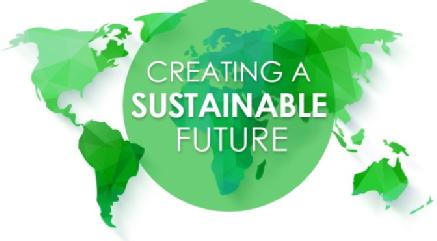 WMG researchers based in the International Institute for Nanocomposites Manufacturing (IINM) have been developing a range of polymer-based solutions for application across several critical sectors, including renewable energy, sustainable transport, and replacement of single use plastics, helping to contribute to a sustainable future.
WMG researchers based in the International Institute for Nanocomposites Manufacturing (IINM) have been developing a range of polymer-based solutions for application across several critical sectors, including renewable energy, sustainable transport, and replacement of single use plastics, helping to contribute to a sustainable future.
Here’s a summary of the key projects.
Renewable Energy: Graphene Enabled All Polymer Solar Thermal Cell
Professor Tony McNally working with Dr Sandeep Kumar in partnership with Senergy Innovations Ltd, has submitted patent applications to the UK Intellectual Property Office that describe 2D material filled polymers for use in Solar Thermal Cells. Critically, the materials developed have very high ‘in-plane’ and ‘through-plane’ thermal conductivity and can be processed using conventional polymer processing methods.
The project was supported by BEIS £11M Energy Entrepreneurs Fund. This scheme is for the development and demonstration of state-of-the art technologies, products, and processes in the areas of energy efficiency, power generation, and heat and electricity storage.
Christine Boyle, CEO of Senergy Innovations Ltd, commented: " Working with the IINM and WMG has allowed Senergy to push the boundaries with innovative technology that has the potential to bring a lot of societal good in sustainability and job creation, also enabling future innovation within the business. Dramatic cost reductions of more than 40% are possible when solar thermal systems are re-engineered with high performance polymers. In 2022 we will work alongside our early customers to showcase how the Senergy solar panels can now reduce the cost of delivering solar hot water and heating to a price point that will finally compete with gas and oil."
Professor McNally said: “We are really excited by this exploitation of our research which has far reaching applications in numerous other sectors, including thermal management in electronic devices and electric vehicles.”
The design for manufacture aspects of the development of the solar thermal cell were supported by the High-Volume Manufacturing (HVM) Catapult and the WMG SME Team.
Sustainable Transport: New Chemistry Enables Conventional Sulphur-vulcanised Tyre Tread Rubbers to Self-heal
Dr Chaoying Wan working with Dr Alan Wemyss in collaboration with Bridgestone EMIA have recently filed a patent application which describes the design and inclusion of dynamic bonds in vulcanised rubbers. This allows the conventional covalent-crosslinked rubber networks to be adaptive to external mechanical damage, self-healable and be reprocessed. The dynamic crosslinking networks also promise excellent mechanical properties and fatigue-resistance that are comparable to conventional rubber vulcanizates.
Dr Raffaele di Ronza, R&D Open Innovation Expert at Bridgestone EMIA commented: “At Bridgestone we have a high focus on sustainability and material technologies to extend tyre life, a key element of our strategy in this field. Through this collaboration with WMG we could explore new solutions that support the realisation of our long-terms targets.”
Dr Chaoying Wan said: “We are delighted with the progress that has been made in improving the sustainability of vulcanised rubber products during our collaboration with Bridgestone. We are now able to further our understanding of self-healing vulcanised rubbers thanks also to the support from WMG and the High Value Manufacturing Catapult which will take us further towards in-depth understanding of elastomer science and new technology development for sustainable elastomer manufacturing.”
Replacement of single-use plastics: Sustainable Bioplastics for Food Packaging Applications
Dr Chaoying Wan and Professor McNally in partnership with Pujing Chemical Industry Co., Ltd., have developed fully biodegradable plastics with the gas barrier and mechanical properties required for food packaging applications. Poly(glycolic acid) or PGA has great potential as a substitute for current single-use plastics used in food packaging applications but with a lower carbon footprint. By blending and promoting interfacial interactions between PGA and other bioplastics, such as PBAT, the team have developed sustainable plastics for food packaging.
In collaboration with Sherkin Technologies UK Ltd., the team have been able to enhance the barrier properties of PGA/PBAT further by crosslinking the outer surface of the films using low energy electron beam treatment.
Dr Bowen Tan, Research Manager (UK), Pujing Chemical Industry Co., Ltd. Stated: “We collaborated with WMG on a research project on the blending of biodegradable plastics for flexible packaging applications. They have provided specialist and a wealth of expertise on plastic processing and modification. WMG is equipped with a wide range of polymer processing and testing equipment which enable our research to be carried out from small to manufacturing scales. The outcome of the project was beyond our expectation.”
Mr Donal O’Sullivan, Managing Director, Sherkin Technologies UK Ltd. Commented: “Plastic packaging plays an important role in the reduction of food waste. Biodegradable food packaging usage has great potential to meet local and global targets for the use of sustainable packaging. The recent work undertaken by the IINM, and their industrial partners is an important step in demonstrating the potential for Low Energy Electron Beam as a platform technology which can be deployed to improve and optimise barrier properties in a new generation of biodegradable films.”
Read more about WMG’s Nanocomposites research here: Nanocomposites (warwick.ac.uk)
Clean Transport Accelerator launched by NatWest and University of Warwick to help SMEs fast-track their innovations
- NatWest and WMG, a department at the University of Warwick, are inviting businesses that are creating the next generation of clean green transport to apply to their new accelerator
- Businesses will receive support to fast-track their innovations, including easy access to clean transport experts and equipment, exclusive 1:1 coaching sessions, and access to growth funding
- The Clean Transport Accelerator is a fully-funded programme and will help the UK be a green leader in carbon-neutral transport for future mobility, helping businesses bring their innovations to the market quicker
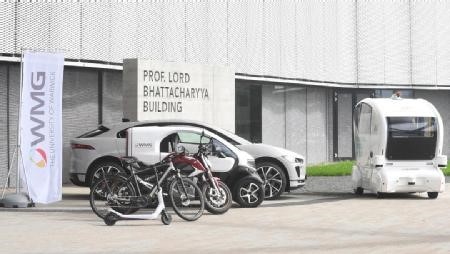 With transport being the largest carbon emitting sector in the UK, a partnership between NatWest and WMG at the University of Warwick has led to the launch of the Clean Transport Accelerator. It will support businesses which are part of the mobility sector to develop products and services that will play their part in achieving the UK’s net-zero goals.
With transport being the largest carbon emitting sector in the UK, a partnership between NatWest and WMG at the University of Warwick has led to the launch of the Clean Transport Accelerator. It will support businesses which are part of the mobility sector to develop products and services that will play their part in achieving the UK’s net-zero goals.
The first cohort of the programme will help 10-15 businesses through education, events, networking and coaching. They will also have access to experts and equipment to help them accelerate their innovations to the market and demonstrate an impact in the pursuit of net zero goals.
Applicants can be from anywhere across the UK and cover a broad range of businesses, whether they are based within supply chains, are fuel providers, want to develop new means of transport, or be focused on specific transport such as light rail, cargo delivery or scooters.
The programme will be delivered jointly by NatWest and WMG, University of Warwick. NatWest will provide an enterprise acceleration manager with 1:1 coaching, access to their accelerator growth events and access to work space, as well as learning hubs at the University of Warwick and Birmingham.
The University of Warwick will provide access to clean energy, manufacturing, automotive and connected experts at WMG and their HVMC (High Value Manufacturing Catapult), as well as the tools to validate and test any equipment designed by the businesses and access to co-working spaces on Campus.
NatWest supported over 55,000 entrepreneurs in 2021 and has 13 accelerator hubs across the UK. Businesses with high growth potential benefit from a range of support through the accelerators. This includes coaching, community, access to a wide network and thought leadership content. NatWest accelerators are keen to attract more female and BAME led businesses as well as companies outside London and the South East. Any business keen to take its next step for growth should consider applying to the NatWest accelerator scheme.
The Clean Transport Accelerator news follows the recent launch of NatWest’s green loans for SMEs and green asset finance through Lombard. Companies can access funds with no arrangement fee to help them transition to more sustainable working practices. The bank has pledged to lend £100 billion by 2025 to businesses looking to invest in being greener. NatWest’s Springboard to Sustainability report, published in October 2021, found that half the UK’s carbon reduction ambition can be delivered by the SME sector and the Clean Transport Accelerator is the bank’s latest offering to help UK SMEs pursue this goal.
Professor David Greenwood, CEO of the High Value Manufacturing Catapult (HVMC) at WMG, University of Warwick comments:
“The drive to net zero has opened up new and exciting opportunities for innovation in the transport sector. Together with NatWest, we’d like to ensure that the UK delivers economic benefits as well as environmental benefits as we meet this critical objective. This programme is aimed to support small and innovative companies as they build and scale up their products, services and business models.”
Richard Hill, Head of Automotive and Manufacturing at NatWest, said:
“NatWest has set out a clear ambition to play a leading role in helping to address the climate challenge, and so we are thrilled to be working with the University of Warwick to offer clean transport businesses a fast-track to delivering on the UK’s green goals.
“Packed with experts, access to equipment, networking opportunities and funding advice, the Clean Transport Accelerator is a must for any business keen to scale up their next step. I look forward to seeing the innovative and exciting businesses that we support.”
Businesses can apply for the Clean Transport Accelerator here: Registration Portal
Where it says ‘Voucher Code’ please enter ‘CleanTransport01/2022’
The deadline for applications is the 11th April 2022.
ENDS
22 FEBRUARY 2022
NOTES TO EDITORS
High-res image available at:
https://warwick.ac.uk/services/communications/medialibrary/images/february_2022/electric_vehicles_outside_wmg_.jpg
Caption: Electric Vehicles outside WMG, University of Warwick
Credit: WMG, University of Warwick
For more information and to apply to the Clean Transport Accelerator visit here
For more information on NatWest’s nationwide accelerators visit here
For more information on NatWest’s green loans visit here
For further information please contact:
Alice Scott
Media Relations Manager – Science
University of Warwick
Tel: +44 (0) 7920 531 221
E-mail: alice.j.scott@warwick.ac.uk
Laura Blumenthal
Media Relations Manager – NatWest
Tel: 07947974464
E-mail: laura.blumenthal@natwest.com
About NatWest Group
NatWest Group is a relationship bank for a digital world. We champion potential; breaking down barriers and building financial confidence so the 19 million people, families and businesses we serve in communities throughout the UK and Ireland can rebuild and thrive. If our customers succeed, so will we.
About WMG, University of Warwick
WMG is a world leading research and education group, transforming organisations and driving innovation through a unique combination of collaborative research and development, and pioneering education programmes.
As an international role model for successful partnerships between academia and the private and public sectors, WMG develops advancements nationally and globally, in applied science, technology and engineering, to deliver real impact to economic growth, society and the environment.
WMG’s education programmes focus on lifelong learning of the brightest talent, from the WMG Academies for Young Engineers, degree apprenticeships, undergraduate and postgraduate, through to professional programmes.
An academic department of the University of Warwick, and a centre for the HVM Catapult, WMG was founded by the late Professor Lord Kumar Bhattacharyya in 1980 to help reinvigorate UK manufacturing and improve competitiveness through innovation and skills development.
Live testing to begin as part of landmark partnership to develop UK electric motorcycle capability
Today (Tuesday 8th February) marks the official end of the collaboration stage of the TE-1 project, a unique four-way partnership with WMG, Triumph Motorcycles, Williams Advanced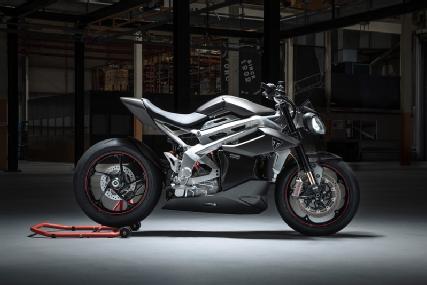 Engineering and Integral Powertrain Ltd e-Drive Division, focusing on developing specialist electric motorcycle technology.
Engineering and Integral Powertrain Ltd e-Drive Division, focusing on developing specialist electric motorcycle technology.
The prototype demonstrator is now fully ready for the live testing programme led by Triumph Motorcycles.
The project, funded by the Office for Zero Emission Vehicles through Innovate UK, was set up to create ground-breaking developments in specialist electric motorcycle engineering and innovative integrated technology design.
Due to WMG’s vast experience and proven track record on key Innovate UK projects, Triumph Motorcycles asked WMG to project manage TE-1 on their behalf.
As part of this WMG was also tasked with identifying the project consortium partners, as well as providing guidance relating to future legislation, charging infrastructure and recycling strategies.
The prototype demonstrator integrates all the latest and final innovations from the project partner workstreams.
Triumph: final chassis, including frame, rear sub-frame, cockpit, panels and wheels, final drive system including transmission and Gates Carbon belt drive, electronics, Öhlins USD cartridge forks, unique prototype Öhlins RSU, Brembo M50 monobloc calipers, and Triumph motorcycle control software
Williams Advanced Engineering: final iteration of prototype WAE battery pack incorporating dedicated cell packaging for optimum centre of gravity, vehicle control unit, DCDC converter, integrated cooling, charge port, and styled carbon covers
Integral Powertrain: final prototype powertrain with scalable integrated inverter and combined motor with silicon carbide switching technology and integrated cooling
WMG: final pre-live trial simulation completed, with all results indicating that the project is on course to deliver the intended performance and durability outcomes
Truong Quang Dinh, WMG’s Associate Professor of Energy Management and Control Systems, explained: “Our creation of initial computer-based simulation models at the start of Phase 1 has been instrumental in ensuring that the component selection was appropriate to achieve the performance targets defined by the partners for the TE-1 Prototype.
“We have continued with this work across Phase 2 of the project, refining the models to a much more complex level to allow us and the partners to imitate further components on the bike such as braking, throttle, lighting and other systems and mimic real-world riding to provide development opportunities and real-time testing before components were fully designed. Additionally, we have created a physical rig wired with all of the control units and e-drivetrain, in order to implement a design validation test programme to ensure the function of each section was within the allowable range.”
Key project achievements so far include test results that exceed current benchmarks and targets set by the UK Automotive Council for 2025, providing a platform with great potential for future development in electric motorcycle performance.
Over the next six months the prototype demonstrator will undertake an extensive live testing programme within Triumph’s state-of-the-art facilities.
At the completion of the live testing phase, estimated to be Summer 2022, the prototype demonstrator will be updated with its final body panels and paint scheme, in preparation for active track demonstration. At this time, the full results of the project including the final specifications and testing outcomes will be published, as well as insights and key facts on how the TE-1 delivers on the project targets for innovation and sets new standards for the motorcycle sector overall, including final battery and range performance.
“It has been truly exciting to see the progress made during phase 3 of Project Triumph TE‑1 with the final prototype motorcycle now going into real life testing. Everyone involved at Triumph are proud to have been part of this innovative British collaboration. Personally, I am thrilled with the results we have already achieved with our partners, and the exciting preview of the potential electric future to come.” said Nick Bloor, Triumph CEO. “We look forward to continuing the ambitious and innovative work on the TE-1 demonstrator prototype through the live testing phase and sharing the outcome with Triumph fans across the world.”
Read more about WMG’s Transport Electrification research expertise here: Energy (warwick.ac.uk)
Autonomous vehicle safety standard concept enables tests needed to be road ready
- Operation Design Domain (ODD) is a fundamental to Connected autonomous Vehicle (CAV) safety, as it describes specific operating conditions in which the CAV system can operate safely, including environmental parameters such as weather an infrastructure
- Defining an ODD in a standard way has now been made official thanks to a new international standard concept created the German standards body ASAM and led by WMG at the University of Warwick, which defines the language used to define an ODD
- The new ASAM OpenODD language concept clears the barrier between CAV manufacturers and authorities, so they can find out if the vehicle is allowed to drive within the authority’s area or not and vice versa
An Operational Design Domain (ODD) is fundamental to Connected Autonomous Vehicle safety, however defining an ODD hasn’t been done before, until now, thanks to the work undertaken by German standardisation body ASAM and led researchers from WMG, University of Warwick.
An Operational Design Domain Definition (ODD) describes specific operating conditions in which the automated driving system is designed to properly operate. It specifies what operating parameters the CAV must be able to manage, for example, weather conditions, infrastructure, location, time of day and everything else that can have an impact on the driving situation. The ODD is thus an important part of the safety concept of a vehicle and must be valid throughout its entire service life for a particular configuration of the CAV.
ASAM, a German standardisation body have been working with WMG, University of Warwick and other international experts to publish a new international standard concept, to develop a language for defining ODDs. They have successfully created a concept for machine-interpretable format to represent the ODD specification. The concept paper can be downloaded free of charge. Additional use cases or requirements can still be proposed before the standard development starts.
Th new format concept enables governments and the automotive industry to access ODD descriptions that are exchangeable, comparable, and processable.
An application example of the effective use of ASAM OpenODD is as follows: A city describes the ODD for its downtown area in the ASAM OpenODD format and makes it available to automotive manufacturers. The manufacturers can then use these descriptions to easily match their vehicles with the defined ODD to find out if their vehicles are allowed to drive in the respective downtown area. They can also use the descriptions to map their scenario test catalogue to the requirements of the ODD. The registration authorities have the benefit of defining ODDs that they can use to check autonomous vehicles. They can also be used to support the development of the ADAS and AD systems, as the use of the ODD can define the testcases that are necessary to validate the vehicle. There can be obvious limitations, for example, if the vehicle is not capable of speeds above 50 km/h highway tests are not necessary. This application of an ODD helps to focus the limited validation resources on the really needed scenarios.
Dr Siddartha Khastgir, from WMG, University of Warwick and project lead for ASAM Open ODD Concept project comments: “Operational Design Domain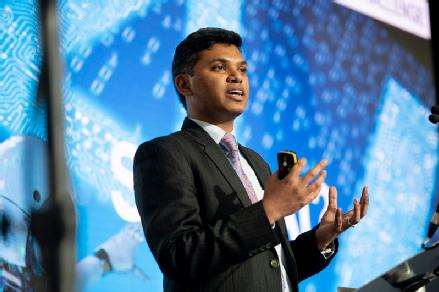 definition is key to creating a safe automated vehicle. However, how is an ODD defined hasn’t been officially deemed, until now, as the ASAM OpenODD concept has provided the language to define an ODD.
definition is key to creating a safe automated vehicle. However, how is an ODD defined hasn’t been officially deemed, until now, as the ASAM OpenODD concept has provided the language to define an ODD.
“This means that going forward CAV manufacturers can define and exchange ODD definitions and authorities can have a common understanding of the ODD definition. I am grateful to all international experts who have contributed to this work. Achieving safety of automated driving needs to be a collaborative effort and ASAM OpenODD is an example of this.”
Peter Voss, Managing Director, ASAM E.V. comments:
"ASAM OpenODD will be a standard that will not only contribute to the safety of automated vehicles, but more importantly, will help to implement automated driving functions faster,".
In addition to the format and syntax, the concept for ASAM OpenODD also takes into account attributes (leveraging ISO 34503), metrics and the representation of uncertainties. The future standard will be compatible with all other standards of the ASAM OpenX family, particularly with OpenDRIVE, OpenSCENARIO and OpenXOntology.
ENDS
1 FEBRUARY 2022
NOTES TO EDITORS
High-res images available at:
https://warwick.ac.uk/services/communications/medialibrary/images/april2020/sid_39.jpg
Caption: Dr Siddartha Khastgir, from WMG, University of Warwick
Credit: WMG, University of Warwick
ASAM OpenODD Concept: https://www.asam.net/standards/detail/openodd/
Recording of webinar: https://www.asam.net/conferences-events/detail/webinar-asam-openodd-concept/
Further resources on understanding ODDs:
What is an ODD (by Nicco Hagedorn, ASAM e.V.): https://www.youtube.com/watch?v=u4F5OZlRlaQ
Curious case blog (by Siddartha Khastgir, WMG): https://bit.ly/CuriousCaseODD
For further information please contact:
Alice Scott
Media Relations Manager – Science
University of Warwick
Tel: +44 (0) 7920 531 221
E-mail: alice.j.scott@warwick.ac.uk
Partnering with Rolls-Royce and Electroflight to create the battery for world’s fastest all-electric aircraft
- The Rolls-Royce ‘Spirit of Innovation’ aircraft is officially the world’s fastest all-electric aircraft, clocking up speeds of 387.4mph
- Rolls-Royce worked in partnership with aviation energy storage specialist Electroflight to create this world-class technical achievement for the UK, that will help lead the way towards a more sustainable way to fly
- In order to power the aircraft, the most power dense propulsion battery pack ever assembled in aerospace had to be developed directly supported by researchers from WMG, University of Warwick using their state-of-the-art battery characterisation and testing facilities
In the wake of COP26 the need for electrification has never been more evident, with aviation top of the list of global priorities.
Committed to taking on this challenge, Rolls-Royce decided to create the ‘Spirit of Innovation’, an all-electric aircraft, which this week officially set not one,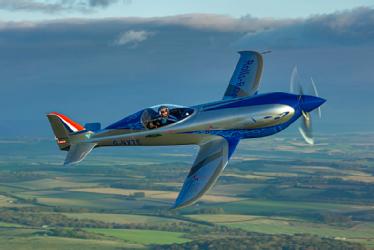 but two World Records and during these record runs it reached speeds of 387.4mph (623 km/h) making it the world’s fastest all-electric vehicle.
but two World Records and during these record runs it reached speeds of 387.4mph (623 km/h) making it the world’s fastest all-electric vehicle.
In embarking on this unprecedented feat, Rolls-Royce partnered with aviation energy storage specialist Electroflight to help develop the battery system for the record-breaking plane. The WMG team at the University of Warwick were exclusively used to test and validate the batteries used on the aircraft.
Using their state-of-the-art facilities at WMG’s Energy Innovation Centre, researchers at WMG supported the team through the development process, conducting extensive electrical, thermal, safety, and vibration & shock testing. This was delivered all the way from Electroflight’s initial single lithium-ion cell selection through to the battery module and finally the battery pack for a full propulsion battery system.
Testing included cell selection, fire protection system design, module level thermal management, system testing and pack level testing, and also included sub-powertrain testing of the battery system and electric machines connected together.
Individual components such as the battery casing materials, individual lithium-ion cells, cell clusters and sub-modules were all examined in WMG’s battery testing laboratories including the Battery Abuse Testing Centre. Aerospace DO-160G shock and vibration testing was performed in WMG’s battery vibration facility – the first time an aircraft propulsion battery has successfully completed DO-160G testing in the UK.
On 16th November, the Spirit of Innovation took to the sky at the UK Ministry of Defence’s Boscombe Down experimental aircraft testing site for its record-breaking flight. Data was submitted to the Fédération Aéronautique Internationale (FAI), who control and certify world aeronautical records, have confirmed that the Spirit of Innovation is the world’s fastest electric plane.
The two new world records broken are:
1. The aircraft reached a top speed of 555.9 km/h (345.4 mph) over 3 kilometres, smashing the existing record by 213.04 km/h (132mph)
2. The aircraft achieved 532.1km/h (330 mph) over 15 kilometres – 292.8km/h (182mph) faster than the previous record
Chief Engineer Mark Amor-Segan, from WMG, University of Warwick comments:
“It’s incredibly exciting to see Rolls-Royce’s ‘Spirit of Innovation’ be awarded two new world records and officially be titled the World’s fastest all-electric aircraft. It has been a tremendous journey to share with Electroflight, to help verify and validate the battery system end-to-end and help create the most power-dense propulsion battery ever for Aerospace.
“We have worked closely with Electroflight and Rolls-Royce throughout this process, cementing new collaborative relationships and helping achieve world-class pioneering technology. To see it progress from literally a single cell into a full-scale battery system and a world-record breaking flight, is tribute to the incredible dedication and capability of the whole team at ACCEL. This project has played a very important part in our work in Aerospace, and we’re excited to continue our research into electrification and the future of sustainable flight.”
Douglas Campbell, Technical Director of Electroflight said:
“This has been a landmark project for our company and our industry – one which opens up a world of possibilities in the electrification of aviation. We’re thrilled to have played such an important part in this success and grateful to our partners at WMG for their support throughout this endeavour.”
Customer Director Matheu Parr from Rolls-Royce added: “The support we received from WMG to develop the battery technology that would power the world’s fastest all-electric aircraft was critical for the team’s record-breaking triumphs. Rolls-Royce has a long-standing relationship with WMG to ensure we are the forefront of technology and we will build on this capability to deliver propulsion and power systems for the advanced air mobility market.”
ENDS
26 JANUARY 2022
NOTES TO EDITORS
High-res images available at:
Pictures and B-Roll video footage can be found here:
https://www.flickr.com/photos/rolls-royceplc/albums/72157705298410174
https://vimeo.com/rollsroyceplc
Credit: Rolls-Royce
FOR FURTHER INFORMATION PLEASE CONTACT:
Alice Scott
Media Relations Manager – Science
University of Warwick
Tel: +44 (0) 7920 531 221
E-mail: alice.j.scott@warwick.ac.uk
